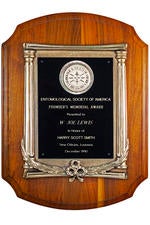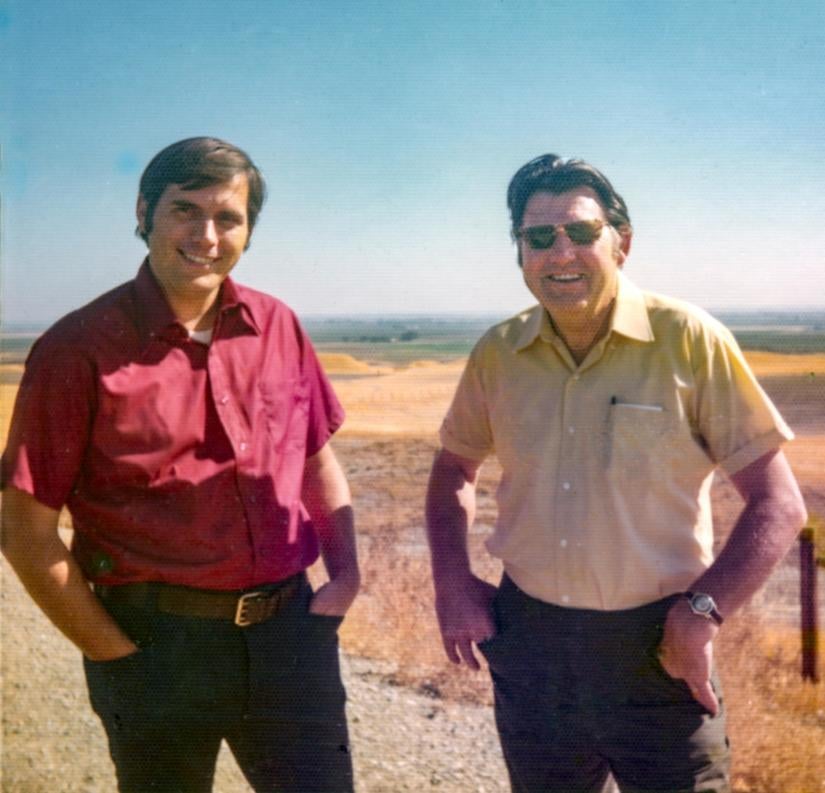
Award plaque in honor
of Prof. Harry Scott Smith
At the 1990 National Meeting of the Entomological Society of America, Dr. W. Joe Lewis was awarded the privilege to present the Founder’s Memorial Lecture in honor of Harry Scott Smith. Dr. Lewis delivered his presentation as part of the opening session of the meeting held in New Orleans, Louisiana, with the title; “Deciphering the Foraging Behavior of Parasitoids: Basic Breakthroughs and Benefits to Biological Control.”
Selection as the Founder’s Memorial Lecturer was, of course, highly gratifying. But, by far, the greater pleasure was the opportunity to use this presentation to honor Prof. Harry Scott Smith, a true giant in our profession. The irony is that on first glance, I would not seem the likely person for such an address in his honor. But, closer examination reveals, not only a connection, but attests further to the far ranging professional impact of this Founder on our discipline.
After growing up as a one-mule sharecropper’s son in south Mississippi, I graduated from high school in 1960, and studied Entomology at Mississippi State University, completing a B.S., 1964; M.S., 1965, and Ph.D., 1967. During graduate school, my interests became focused on biological control with strong interests in parasitic and predacious insects. Rachel Carson’s “Silent Spring” movement was underway, and interest in biological control was growing. But such activities throughout the south and southeast USA were very limited, as of that time, as were opportunities for collaboration on biological control research.
During my undergraduate years, I studied and read about biocontrol research programs that were transpiring in California, many of which had been started under Harry Scott Smith’s leadership. So, these projects became an early source of inspiration. Then in December of 1965, shortly after completing my Masters degree, I attended my first National Meeting of the Entomological Society of America, also, in New Orleans. At that meeting I met Drs. Kenneth Hagen and Leopoldo Caltagirone. I still remember well recognizing who they were and introducing myself in a foyer areanear one of the meeting rooms. After, a brief discussion they invited me to go sit with them at one of the lounge areas, and inquired with much genuine interest about my graduate research activities and objectives, together with suggestions and encouragement. I was pleasantly amazed with the level of outreach and kindness they extended. But, I went on to learn that it was more than that. Not only had I just met two caring and accommodating men, I had encountered a culture fostered by Harry Scott Smith and one still being practiced by his disciples to the benefit of many.
Ken Hagen invited me to stay in touch, and of course I did. We went on to become close friends, and to cooperate on several research projects, including a number of exchange visits to one another’s laboratories and homes. Furthermore, my connection with the Harry Scott Smith sphere of influence expanded to include collaborative interactions with numerous other influential researchers in biological control, including: Carl Huffaker, Robert van den Bosch, Donald Dahlsten, Richard Garcia, and P. S. Messenger. These interactions culminated with a Visiting Professor assignment for several months at the Gill Tract, in Albany California in 1981. Indeed, my career was richer and more productive through the vast impact of this remarkable man, Prof. Harry Scott Smith.
This page was written by Dr. W. Joe Lewis, Retired Research Entomologist, USDA-ARS, Tifton, Georgia, USA and ESA Fellow (2008)

